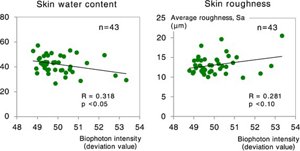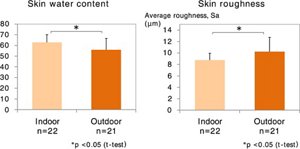Biophoton-associated chronic photodamage of skin, including skin dehydration and surface roughness
This is an English translation of a news release in Japanese on September 30.
The Skin Care Research, Analytical Science Research, and Biological Science Research Divisions of Kao Corporation (CEO: Mr. Michitaka Sawada) have been pursuing novel methods for determination of invisible photodamage in skin via evaluation of biophotons, ultraweak photons emitted from the body, in order to prevent photoaging. The present findings reveal a unique set of skin conditions leading to a decrease in skin water content as well as increase in skin surface roughness caused by oxidative damage, represented by higher biophoton emissions from 1 to 3 minutes after ultraviolet (UV) exposure. Furthermore, these typical changes in skin were shown to be related to a history of chronic sun exposure.
Taken together, the present results indicate that chronic UV damage can lead to photoaging via an early skin deterioration process, resulting in skin dehydration accompanied by surface roughness.
Kao presented these research findings at the 49th Annual Meeting of European Society of Dermatology Research in Bordeaux, France (September 18 to 21, 2019).
Background
Ultraviolet (UV) light, a leading cause of various types of damage, induces not only a sunburn/suntan response in skin, but also accelerates symptoms of skin aging, such as pigment spots, wrinkles, and sagging, via the process of photoaging. UV-induced oxidative damage including oxidized lipids is known to be the main photoaging cause. Kao researchers have performed evaluations of invisible UV-induced skin damage by detecting biophotons, ultraweak photons emitted by various oxidized components from the body. Among those oxides, UV-induced lipid peroxides have been found to essentially represent hidden skin damage, which can be determined by measuring the levels of long-lasting biophotons emitted from 1 to 3 minutes after UV irradiation, as noted in a recent news release in June 2019*1 . Those lines of evidence also showed that with an increase in biophotons generated from 1 to 3 minutes after UV exposure, skin is more likely to become sensitive to UV-induced damage.
-
* 1 June 11 2019, Kao News Release
"Novel Measurement of Invisible Photodamage in the Skin via the Detection of Biophoton, an Ultraweak Photon Emitted from the Body"
https://www.kao.com/global/en/news/2019/20190611-001/
Higher level of biophotons in skin leads to decreased skin hydration and increased skin surface roughness
For the present study, Kao assumed that certain phenotypic changes caused by accumulation of UV damage could become more pronounced in skin with higher amounts of biophotons. Thus, the researchers determined biophoton amounts from 1 to 3 minutes after UV irradiation in 43 female volunteers (age 20s) with a variety of skin conditions. Those findings showed that susceptibility to UV damage revealed by higher biophoton production tended to be related to decreased water content in the stratum corneum and increased skin surface roughness (Fig. 1).

Fig. 1. Relationship of biophotons with skin properties
Accumulation of UV damage exerts primary effects on skin over course of photoaging
Consumers show increased concerned about skin aging effects, such as pigmented spots and wrinkles, in their 30s, though UV damage is more likely to accumulate on a daily basis. Kao researchers speculated that unintended skin damage might proceed prior to development of an obvious photoaging phenotype.
The relationship between history of sun exposure and skin condition was examined in female volunteers (n=43, age 20s) who did not have major skin concerns such as pigment spots or wrinkles. The subjects were divided into the Indoor (n=22) and Outdoor (n=21) groups according to history of sun exposure, which was determined by use of a modified questionnaire that assumed a standard sun exposure history from the age of 6 years to the present*2 . Among the various skin properties examined in the subjects, it was noteworthy that water content in the stratum corneum was significantly decreased and skin surface roughness was significantly increased in the Outdoor group as compared with the Indoor group (Fig. 2).
-
* 2 "Measures of sun exposure and sun protection practices for behavioral and epidemiologic research."
Arch. Dermatol. 144, 217-22 (2008)

Fig. 2. Sun exposure-related changes in skin
Conclusion
Daily UV exposure can lead to accumulation of photodamage in skin, which is more apparent in damage-sensitive skin with possibly greater biophoton generation. These findings reflect some typical skin properties, including skin dehydration and skin roughness, that consistently occur following significant aggravation of skin condition due to a history of sun exposure, even in younger women. Thus, it should be considered that chronic UV damage primarily represents skin changes that later develop into photoaging.
Kao will continue to develop novel technologies for thorough protection of skin from UV for prevention of photoaging.
